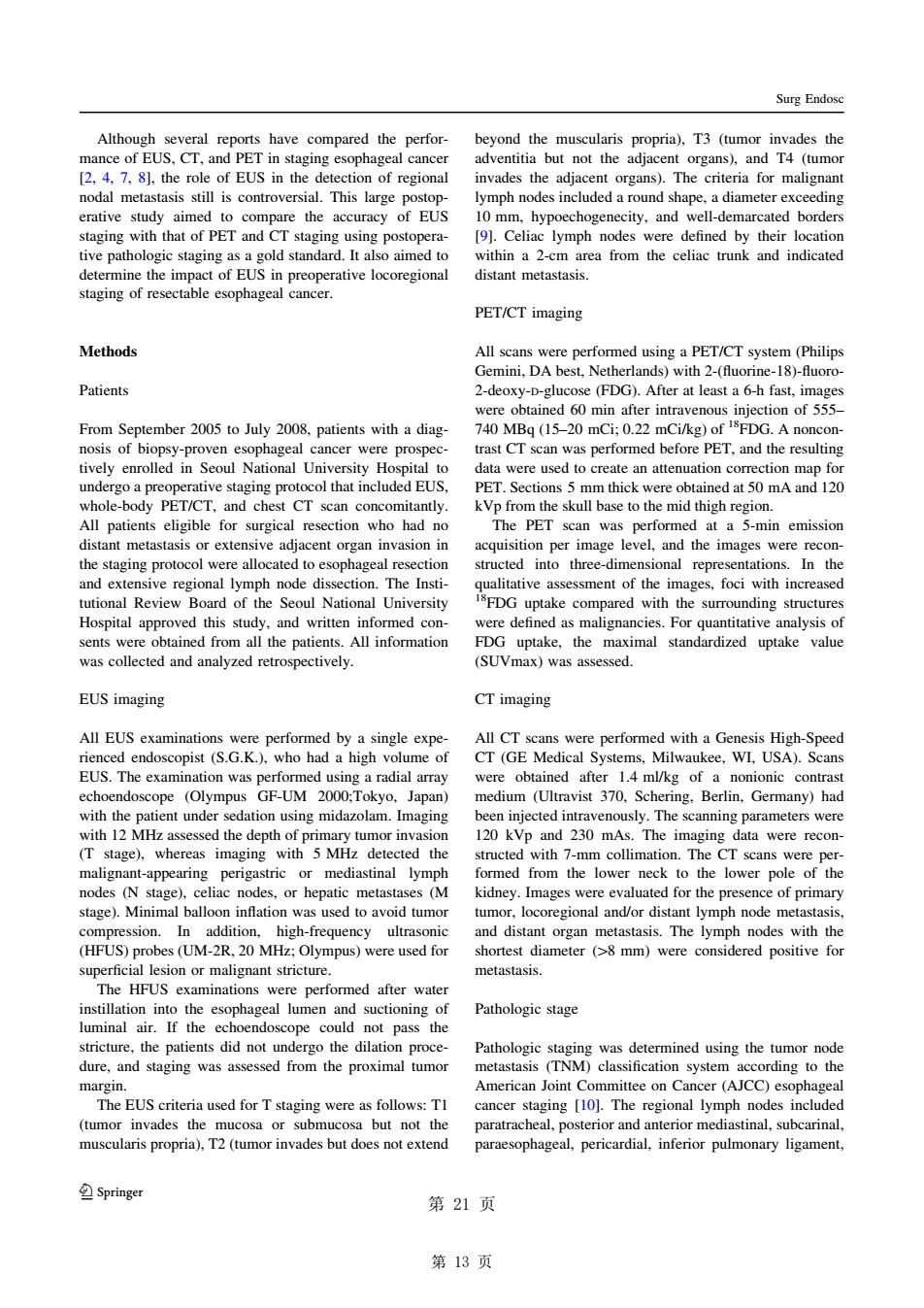正在加载图片...

Surg Endose beyond the musculari [2.4.7.8].the role of EUS in the detection of regional invades the adjacent organs).The criteria for malignan me This large of EUS staging with that of PET and CT staging using po [ol Celiac lymph nodes were defined by their locatior PET/CT imaging Methods Patients 2-deoxy-p-lucose (FDG).After at least a 6-h fast.image tember 05to July0.patients withadi (20: /kg A n d th to data were used to create an attenuation correction map fo All patients eligible for surgical resection who had no The PET scan was distant metastasis or extensive adjacent organ invasion in acquisition per image level,and the images were recon he staging protocol sophage into three- repr In the Hospital approved this study.and written informed con- ned as malignancies.For quantitative nalysis of from All information 59 le e EUS imaging CT imaging All fus exa tion h AJ CT sea EUS.The examina GF-UM ion was perfor radial ar were obtained after 1.4 ml/kg of a nonionic contras Japa 37 ng,Berlin,Germany)ha with 12 MHz assessed the depth of prin ary tumor inv 120 kVp and 230 mAs.The imaging data were recon T stage),whereas imaging with 5 MH h 7-mm collimation.Th CT scans the were per d for th ower pol of th stage).Minimal balloon inflation was used to avoid tumor distant ()( high-frequency ultrasoni and distant organ metastasis.The lymph nodes with the ympus)were used fo (>8 mm)were con lered positive fo The hFUs examinations were performed after water Pathologic stage dure.and staging was assessed from the proximal tumor American Jou on C er (AJC (tumor invades the muc aratracheal muscularis propria).T2(tumor invades but does not extend paraesophageal,pericardial,inferior pulmonary ligament, Springer 第21页 第13页 Although several reports have compared the performance of EUS, CT, and PET in staging esophageal cancer [2, 4, 7, 8], the role of EUS in the detection of regional nodal metastasis still is controversial. This large postoperative study aimed to compare the accuracy of EUS staging with that of PET and CT staging using postoperative pathologic staging as a gold standard. It also aimed to determine the impact of EUS in preoperative locoregional staging of resectable esophageal cancer. Methods Patients From September 2005 to July 2008, patients with a diagnosis of biopsy-proven esophageal cancer were prospectively enrolled in Seoul National University Hospital to undergo a preoperative staging protocol that included EUS, whole-body PET/CT, and chest CT scan concomitantly. All patients eligible for surgical resection who had no distant metastasis or extensive adjacent organ invasion in the staging protocol were allocated to esophageal resection and extensive regional lymph node dissection. The Institutional Review Board of the Seoul National University Hospital approved this study, and written informed consents were obtained from all the patients. All information was collected and analyzed retrospectively. EUS imaging All EUS examinations were performed by a single experienced endoscopist (S.G.K.), who had a high volume of EUS. The examination was performed using a radial array echoendoscope (Olympus GF-UM 2000;Tokyo, Japan) with the patient under sedation using midazolam. Imaging with 12 MHz assessed the depth of primary tumor invasion (T stage), whereas imaging with 5 MHz detected the malignant-appearing perigastric or mediastinal lymph nodes (N stage), celiac nodes, or hepatic metastases (M stage). Minimal balloon inflation was used to avoid tumor compression. In addition, high-frequency ultrasonic (HFUS) probes (UM-2R, 20 MHz; Olympus) were used for superficial lesion or malignant stricture. The HFUS examinations were performed after water instillation into the esophageal lumen and suctioning of luminal air. If the echoendoscope could not pass the stricture, the patients did not undergo the dilation procedure, and staging was assessed from the proximal tumor margin. The EUS criteria used for T staging were as follows: T1 (tumor invades the mucosa or submucosa but not the muscularis propria), T2 (tumor invades but does not extend beyond the muscularis propria), T3 (tumor invades the adventitia but not the adjacent organs), and T4 (tumor invades the adjacent organs). The criteria for malignant lymph nodes included a round shape, a diameter exceeding 10 mm, hypoechogenecity, and well-demarcated borders [9]. Celiac lymph nodes were defined by their location within a 2-cm area from the celiac trunk and indicated distant metastasis. PET/CT imaging All scans were performed using a PET/CT system (Philips Gemini, DA best, Netherlands) with 2-(fluorine-18)-fluoro- 2-deoxy-D-glucose (FDG). After at least a 6-h fast, images were obtained 60 min after intravenous injection of 555– 740 MBq (15–20 mCi; 0.22 mCi/kg) of 18FDG. A noncontrast CT scan was performed before PET, and the resulting data were used to create an attenuation correction map for PET. Sections 5 mm thick were obtained at 50 mA and 120 kVp from the skull base to the mid thigh region. The PET scan was performed at a 5-min emission acquisition per image level, and the images were reconstructed into three-dimensional representations. In the qualitative assessment of the images, foci with increased 18FDG uptake compared with the surrounding structures were defined as malignancies. For quantitative analysis of FDG uptake, the maximal standardized uptake value (SUVmax) was assessed. CT imaging All CT scans were performed with a Genesis High-Speed CT (GE Medical Systems, Milwaukee, WI, USA). Scans were obtained after 1.4 ml/kg of a nonionic contrast medium (Ultravist 370, Schering, Berlin, Germany) had been injected intravenously. The scanning parameters were 120 kVp and 230 mAs. The imaging data were reconstructed with 7-mm collimation. The CT scans were performed from the lower neck to the lower pole of the kidney. Images were evaluated for the presence of primary tumor, locoregional and/or distant lymph node metastasis, and distant organ metastasis. The lymph nodes with the shortest diameter ([8 mm) were considered positive for metastasis. Pathologic stage Pathologic staging was determined using the tumor node metastasis (TNM) classification system according to the American Joint Committee on Cancer (AJCC) esophageal cancer staging [10]. The regional lymph nodes included paratracheal, posterior and anterior mediastinal, subcarinal, paraesophageal, pericardial, inferior pulmonary ligament, Surg Endosc 123 义 第 13 页��